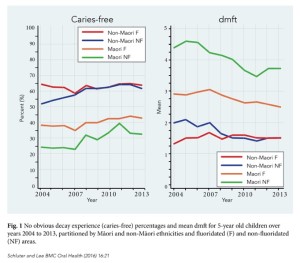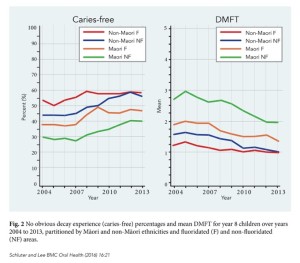- Fluoride does not work by swallowing The 1940s theory that fluoride needed to be incorporated into the tooth enamel by swallowing it, has been thoroughly discredited by both supporters and opponents of fluoridation. It is not even touted anymore by those pushing fluoridation today. Fluoride promoters now claim that if there is any benefit from fluoride it is from contact with the surface of the tooth.
“For many years it was believed that [fluoride] worked systemically. It is now generally accepted that it works topically” – Judge Hansen, High court, New Plymouth 2014
- Too much fluoride causes Dental fluorosis. Ministry of Health says 40% of children in NZ have some form of dental fluorosis. Dental fluorosis is the first outward sign of over-exposure to fluoride i.e. fluoride poisoning, therefore no amount of dental fluorosis is acceptable. NZ research that has looked specifically at dental health and lifetime fluoride exposure has found twice the rate of dental fluorosis in fluoridated than in non-fluoridated areas (30% compared to 15%). Obviously fluoride exposure needs to be urgently reduced not extended.
- Fluoride is a neurotoxin. There are now 59 human studies that have looked at fluoride exposure and effects on brain function. 52 of these show fluoride’s damaging effect: lowered IQ, behavioral deficits, nervous disorders, and memory disruption. One of these studies was funded by the US Government and published in Environmental Perspectives. It shows exposure in utero at the same levels people are exposed to NZ causing a lowering of IQ. Read more about that here. There are also hundreds of animal studies showing fluoride’s adverse effects on the brain. In March 2014 fluoride was classified as a neurotoxin in world renowned medical journal, The Lancet.
- Dose cannot be guaranteed as safe. The US Government’s prestigious National Toxicology Program is now reviewing all of the fluoride-brain studies and is conducting its own new animal studies. Panel member, Dr Linda Birnbaum, voiced her concerns, saying, “We know nothing about individual vulnerability and susceptibility.” Dr Birnbaum also stated that we do know already that fluoride’s affect on the brain could occur as low as 2.7ppm, and stated that this leaves a very small margin of safety, particularly as individual doses are unmonitored. See video recording of the committee meeting.
- Fluoride accumulates in our bones and soft tissue. In countries with high amounts of naturally occurring fluoride such as China, India and Senegal, fluoride is removed from the drinking water to avoid people developing skeletal fluorosis. The first stage of skeletal fluorosis is identical to arthritis. 2 – 8 mg per day over a long period is considered to be the dose likely to cause this.
- Fluoride is an endocrine disruptor. The US National Research Council’s, 12-member, three-year review of all fluoride science found that extremely low levels of fluoride affect the human thyroid – between 0.05mg/kg/day – 0.13 mg/kg/day when iodine is adequate and 0.01mg/kg/day – 0.03 mg/kg/day when iodine is inadequate. Many New Zealanders will be exceeding this dose.
- Bottle-fed babies receive very dangerous amounts of fluoride. Human breast milk contains almost no fluoride, New Zealand fluoridated water is normally 0.85ppm which is 212 times more fluoride than breast milk. Any reasonable person can see it is utterly reckless to give this dose to bottle-fed babies.
- Fluoridation chemicals are hazardous waste products. Fluoridation chemicals are scrubbed from the chimneys of the phosphate fertiliser industry. They contain contaminants such as lead, arsenic, mercury and sometimes uranium. Why increase our ingestion of any amount of these substances?
- Fluoridation is a violation of the right to informed consent to medical treatment. Fluoridation chemicals are added to the drinking water for the sole purpose of providing a claimed therapeutic benefit to teeth. The fact that the Government introduced Legislation to exempt all fluoride chemicals from the Medicines Act if they are added to the drinking water, does not change the fact that fluoridation chemicals are being used to treat people for a medical condition. All it does is show that the Government can do whatever it likes by introducing laws whenever it feels like it, no matter how nonsensical that law is. See this Opinion Piece, which first appeared in the Timaru Courier in May 2016, by Tom O’Connor, Grey Power president, which provides the conclusive case explaining this violation.
- Less than 5% of the world is still fluoridating water supplies, with more and more cities stopping every year for the past several decades. 98% of Europe does not have water fluoridation. And their teeth are just as good if not better than ours. Only four countries in Europe have some salt fluoridated. Only 10% of the UK is fluoridated. Only three countries in the world have mandatory fluoridation; Ireland, Singapore and Israel. Currently, Israel’s fluoridation policy is being challenged in the Supreme Court. China and Japan have banned fluoridation. China, India and Senegal remove fluoride from water supplies with more than 1ppm.
- Fluoridation does not reduce dental decay. The most recent New Zealand study, carried out by pro-fluoride dentists, shows there is no difference in decay rates between non-Maori children in fluoridated and non-fluoridated areas (see graphs below). One of the differences seen with Maori children is likely due to lack of access to dental care, as the study found Maori children less likely to have had a dental examination. The prestigious international Cochrane Review, published in 2015, also found no modern reliable evidence of fluoridation reducing dental decay. All data received by Fluoride Free New Zealand from NZ District Health Boards on the severity of tooth decay have shown us that the rates of severe tooth decay are the same, if not more prevalent, in children in fluoridated areas versus non-fluoridated areas.
- Other countries have successful public dental health policies without fluoridation.There are successful international dental programmes that put fluoridation to shame in every way, saving money as well as reducing pain and suffering. Countries such as Scotland, Wales and Japan have targeted programmes which include tooth brushing in schools and pre-schools, education for parents and children, and ensuring all children are seen every 6 to 12 months by a dental professional. Dental health of children in Scotland now exceeds New Zealand rates.
Caries free – no dental decay
dmft – decayed, missing or filled deciduous (baby) teeth
DMFT – decayed, missing or filled permanent teethKey Messages


